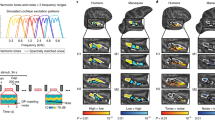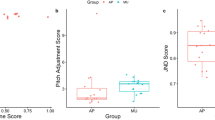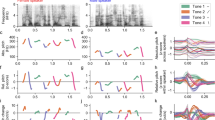Abstract
Pitch perception is critical for identifying and segregating auditory objects1, especially in the context of music and speech. The perception of pitch is not unique to humans and has been experimentally demonstrated in several animal species2,3. Pitch is the subjective attribute of a sound's fundamental frequency (f0) that is determined by both the temporal regularity and average repetition rate of its acoustic waveform. Spectrally dissimilar sounds can have the same pitch if they share a common f0. Even when the acoustic energy at f0 is removed (‘missing fundamental’) the same pitch is still perceived1. Despite its importance for hearing, how pitch is represented in the cerebral cortex is unknown. Here we show the existence of neurons in the auditory cortex of marmoset monkeys that respond to both pure tones and missing fundamental harmonic complex sounds with the same f0, providing a neural correlate for pitch constancy1. These pitch-selective neurons are located in a restricted low-frequency cortical region near the anterolateral border of the primary auditory cortex, and is consistent with the location of a pitch-selective area identified in recent imaging studies in humans4,5.
This is a preview of subscription content, access via your institution
Access options
Subscribe to this journal
Receive 51 print issues and online access
$199.00 per year
only $3.90 per issue
Buy this article
- Purchase on Springer Link
- Instant access to full article PDF
Prices may be subject to local taxes which are calculated during checkout





Similar content being viewed by others
References
Moore, B. C. J. An Introduction to the Psychology of Hearing (Academic, London, 2003)
Tomlinson, R. W. & Schwarz, D. W. Perception of the missing fundamental in nonhuman primates. J. Acoust. Soc. Am. 84, 560–565 (1988)
Heffner, H. & Whitfield, I. C. Perception of the missing fundamental by cats. J. Acoust. Soc. Am. 59, 915–919 (1976)
Patterson, R. D., Uppenkamp, S., Johnsrude, I. S. & Griffiths, T. D. The processing of temporal pitch and melody information in auditory cortex. Neuron 36, 767–776 (2002)
Penagos, H., Melcher, J. R. & Oxenham, A. J. A neural representation of pitch salience in nonprimary human auditory cortex revealed with functional magnetic resonance imaging. J. Neurosci. 24, 6810–6815 (2004)
Cariani, P. A. & Delgutte, B. Neural correlates of the pitch of complex tones. I. Pitch and pitch salience. J. Neurophysiol. 76, 1698–1716 (1996)
Cedolin, L. & Delgutte, B. Pitch of complex tones: rate-place and interspike interval representation in the auditory nerve. J. Neurophysiol. 94, 347–362 (2005)
Whitfield, I. C. Auditory cortex and the pitch of complex tones. J. Acoust. Soc. Am. 67, 644–647 (1980)
Zatorre, R. J. Pitch perception of complex tones and human temporal-lobe function. J. Acoust. Soc. Am. 84, 566–572 (1988)
Warrier, C. M. & Zatorre, R. J. Right temporal cortex is critical for utilization of melodic contextual cues in a pitch constancy task. Brain 127, 1616–1625 (2004)
Schwarz, D. W. & Tomlinson, R. W. Spectral response patterns of auditory cortex neurons to harmonic complex tones in alert monkey (Macaca mulatta). J. Neurophysiol. 64, 282–298 (1990)
Fishman, Y. I., Reser, D. H., Arezzo, J. C. & Steinschneider, M. Pitch vs. spectral encoding of harmonic complex tones in primary auditory cortex of the awake monkey. Brain Res. 786, 18–30 (1998)
Morel, A. & Kaas, J. H. Subdivisions and connections of auditory cortex in owl monkeys. J. Comp. Neurol. 318, 27–63 (1992)
Morel, A., Garraghty, P. E. & Kaas, J. H. Tonotopic organization, architectonic fields, and connections of auditory cortex in macaque monkeys. J. Comp. Neurol. 335, 437–459 (1993)
Fay, R. R. Hearing in Vertebrates: A Psychophysics Databook (Hill-Fay, Winnetka, 1988)
Pollack, I. Detection and relative discrimination of auditory “jitter”. J. Acoust. Soc. Am. 43, 308–315 (1968)
Yost, W. A., Patterson, R. & Sheft, S. The role of the envelope in processing iterated rippled noise. J. Acoust. Soc. Am. 104, 2349–2361 (1998)
Schulze, H. & Langner, G. Periodicity coding in the primary auditory cortex of the Mongolian gerbil (Meriones unguiculatus): two different coding strategies for pitch and rhythm? J. Comp. Physiol. A 181, 651–663 (1997)
Schulze, H., Hess, A., Ohl, F. W. & Scheich, H. Superposition of horseshoe-like periodicity and linear tonotopic maps in auditory cortex of the Mongolian gerbil. Eur. J. Neurosci. 15, 1077–1084 (2002)
Ritsma, R. J. Existence region of the tonal residue. I. J. Acoust. Soc. Am. 34, 1224–1229 (1962)
Pressnitzer, D. & Patterson, R. D. Distortion products and the perceived pitch of harmonic complex tones. in Physiological and Psychophysical Bases of Auditory Function (eds Breebart, D. J., Houtsma, A. J. M., Kohlrausch, A., Prijs, V. F. & Schoonoven, R.) 97–104 (Shaker, Maastricht, 2001)
McAlpine, D. Neural sensitivity to periodicity in the inferior colliculus: evidence for the role of cochlear distortions. J. Neurophysiol. 92, 1295–1311 (2004)
Rauschecker, J. P. & Tian, B. Processing of band-passed noise in the lateral auditory belt cortex of the rhesus monkey. J. Neurophysiol. 91, 2578–2589 (2004)
Pantev, C., Hoke, M., Lutkenhoner, B. & Lehnertz, K. Tonotopic organization of the auditory cortex: pitch versus frequency representation. Science 246, 486–488 (1989)
Langner, G., Sams, M., Heil, P. & Schulze, H. Frequency and periodicity are represented in orthogonal maps in the human auditory cortex: evidence from magnetoencephalography. J. Comp. Physiol. A 181, 665–676 (1997)
Epple, G. Comparative studies on vocalization in marmoset monkeys (Hapalidae). Folia Primatol. (Basel) 8, 40 (1968)
Suga, N. Processing of auditory information carried by species-specific complex sounds. in The Cognitive Neurosciences (ed. Gazzanica, M. S.) 295–313 (MIT Press, Cambridge, Massachusetts, 1994)
Goldstein, J. L. An optimum processor theory for the central formation of the pitch of complex tones. J. Acoust. Soc. Am. 54, 1496–1516 (1973)
Schouten, J. F. The residue and the mechanism of hearing. Proc. K. Ned. Akad. Wet. 43, 991–999 (1940)
Lu, T., Liang, L. & Wang, X. Temporal and rate representations of time-varying signals in the auditory cortex of awake primates. Nature Neurosci. 4, 1131–1138 (2001)
Acknowledgements
This work was supported by NIH grants to X.W. and D.B. We thank B. Delgutte, D. McAlpine, E. Young, B. Moore and members of the Laboratory of Auditory Neurophysiology for their comments and suggestions related to this manuscript, and A. Pistorio, E. Bartlett and E. Issa for assistance with animal care. E. Issa contributed data to the characteristic frequency maps.Author Contributions D.B. and X.W. designed the experiment and co-wrote the paper. D.B. carried out the electrophysiological recordings and data analysis.
Author information
Authors and Affiliations
Corresponding authors
Ethics declarations
Competing interests
Reprints and permissions information is available at npg.nature.com/reprintsandpermissions. The authors declare no competing financial interests.
Supplementary information
Supplementary Figure S1
This shows responses of pitch-selective and non-pitch neurons to pure tone MFs. (PDF 876 kb)
Supplementary Figure S2
This figure shows the cortical frequency maps and location of pitch-selective neurons in two of the subjects as well as the distribution of standard deviation of CF across the maps of all three subjects (PDF 770 kb)
Supplementary Figure S3
This figure shows two examples of a pitch-selective neuron’s response to pure tone and MFs (PDF 407 kb)
Supplementary Figure S4
This figure shows three examples of a pitch-selective neuron's response to complex sounds (irregular click trains and iterated ripple noise) varying in their pitch salience (PDF 619 kb)
Supplementary Figure S5
This figure shows the response of pitch selective neurons to the noise masker played alone, as well as an example of a pitch selective neuron's response to pure tones and MFs in the presence of a noise masker. (PDF 402 kb)
Supplementary Figure Legends
Text to accompany the above Supplementary Figures. (DOC 26 kb)
Rights and permissions
About this article
Cite this article
Bendor, D., Wang, X. The neuronal representation of pitch in primate auditory cortex. Nature 436, 1161–1165 (2005). https://doi.org/10.1038/nature03867
Received:
Accepted:
Issue Date:
DOI: https://doi.org/10.1038/nature03867
This article is cited by
-
Spontaneous emergence of rudimentary music detectors in deep neural networks
Nature Communications (2024)
-
Cortical representation of musical pitch in event-related potentials
Biomedical Engineering Letters (2023)
-
A Music Cognition–Guided Framework for Multi-pitch Estimation
Cognitive Computation (2023)
-
Music in the brain
Nature Reviews Neuroscience (2022)
-
Deep neural network models reveal interplay of peripheral coding and stimulus statistics in pitch perception
Nature Communications (2021)
Comments
By submitting a comment you agree to abide by our Terms and Community Guidelines. If you find something abusive or that does not comply with our terms or guidelines please flag it as inappropriate.



